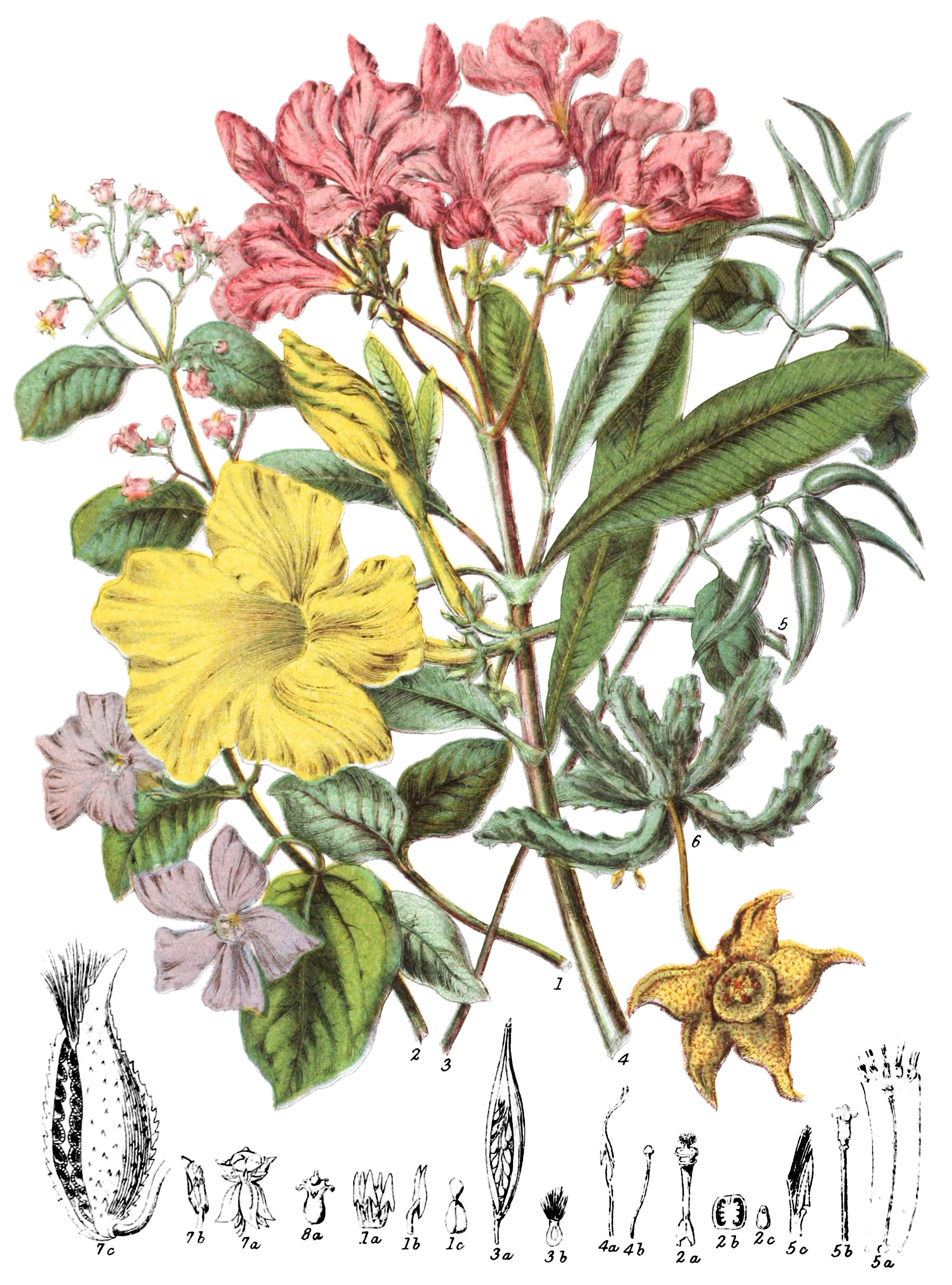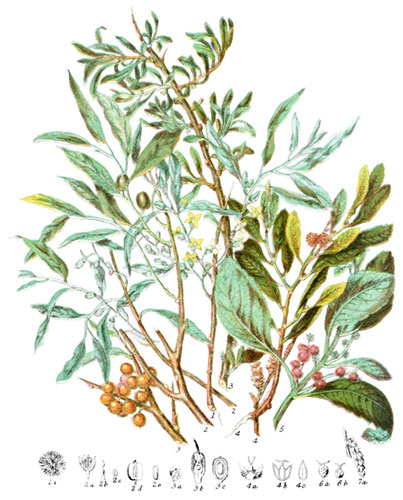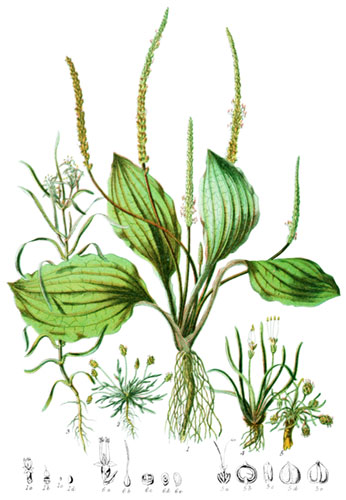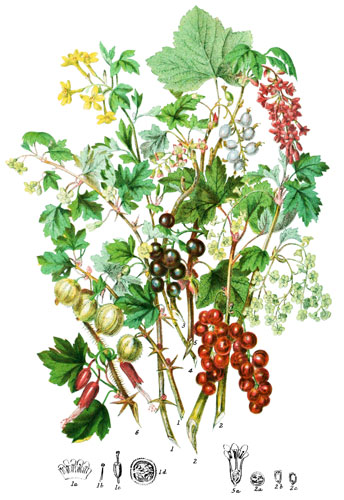Key characteristics
Trees, shrubs, and a few herbaceious plants, usually with milky juice, often of a climbing habit. The leaves are opposite, sometimes alternate, or in circles on the stem, entire at the edges, without stipules, but having hairs or glands upon or between the leaf-stalks. The flowers generally grow from between the leaf-stalks. The calyx is five-parted; the corolla of one petal is attached to the base of the ovary, often having scales at the throat, five-lobed, twisted or folded over in the bud. The stamens are five, placed on the corolla, alternate with its segments; the filaments of Apocynum are distinct; of Asclepias and others, combined; the grains of pollen are distinct in general, but double in masses in Asclepias; the ovaries are two, with two styles, and one stigma, contracted in the middle in Apocynum, five-cornered with glands at the angles in Asclepias. The fruit is a follicle, capsule, drupe, or berry, double or single; the seeds are numerous, usually hairy at the scar, with thin, fleshy, or cartilaginous albumen.
This Tribe has affinity with the Gentianaceæ, but the form of the stigma is an obvious distinction, as well as the milky juice.
An acrid juice, sometimes containing caoutchouc, often poisonous, exists in these plants.
A great variety is found in this tribe; some species are remarkable for brilliant flowers; others, for the succulent leafless stalks; some are slender herbs, others have a large twisted stem coiled on the ground before rising upwards.
Select plants in this order
Not all plants listed are illustrated and not all plants illustrated are listed.
- In the time of Pliny, Apocynum was supposed to be poisonous to dogs, whence its name.
- A. hypericifolium (1) contains, like other species, an acrid juice; the glutinous stigma attracts flies, and the irritable stamens close on them.
- The stalks of A. cannabinum yield a strong fibre, used by the North American Indians as hemp, making from it nets, fishing-lines, and garments.
- A. venetum belongs to the Isles of the Adriatic.
- Vinca (2) flouishes well in shrubberies under the shade and dripping of trees; if not really indiginous, it has become naturalized in many parts of England; the juice of the plant contains gallic acid, but is not milky.
- Cynanchum nigrum (3) has a singular aspect when the seed-vessels are formed, though the flowers are insignificant.
- Some of the most ornamental plants of this tribe have poisonous properties.
- Nerium (4), so beautiful in its native countries of the East, adorning the borders of streams, is considered very injurious; the natives of India have a superstitious dread of its baneful effects. In Spain, where it grows abundantly, the wood is seldom used, on account of its unwholesome juice; which is, however, not milky, as in most of the deleterious species. The simple leaves have a tough skin: after being soaked in water, the strong midrib may be easily drawn out by the stalk, and the pulp extracted; thus a leaf is clarly proved to be a bag.
- Among the more strongly poisonous plants is Tanghinia venenifera in Madgascar, where formerly criminals were commanded to eat of the fruit, and if they survived, were considered innocent; a rare occurence, for one kernel would suffice to poison twenty persons.
- Gonolobus macrophyllus is used by the Indians of North America to poison their arrows.
- Echites affords brilliant flowers in our conservatories, and poison for the arrows of the Mandingoes in Africa.
- Hasseltia and others are also excessively acrid.
- Plumiera is a genus of fine flowers, but corrosive juices.
- Allamanda (5) was discovered in Guiana by Aublet, who saw and figured its large rough seed-vessel, which is now produced in this climate.
- Ascelpias is the type of the division with stamens fixed round the style in a column; it belongs almost exclusively to North America, A. curassavica alone growing in South America.
- A. syriaca (7)* is one of the sweet-scented and useful plants of Virginia; the French Canadians eat the young shoots, prepare sugar from the flowers, and collect the silky down of the seeds to stuff beds.
- The fleshy roots of A. nivea are used medicinally.
- Stapelia, named from Stapel, a Dutch commentator on Theophrastus 200 years ago, is a curious genus; the succulent stalks assume divers strange forms, and the flowers have a peculiar aspect, sometimes from their star-shape, tough substance, and hairy clothing appearing to be a link, outwardly at least, with some of the lower tribes of animals. Many of them have an extremely disagreeable odour: like other succulent plants, they exist in a dry soil; a few are said to afford food to the Hottentots.
- Hoya carnosa is a climbing plant from Asia, now seen in almost all conservatories with its honey-bearing waxen flowers and fleshy leaves.
- H. campanulata has elegant clusters of pale buff flowers.
- Sarcostemma is a singular leafless climber.
- Caoutchouc exists in the milky juice of several species: in Collophora and Cameraria† of South America; in Vahea‡ of Madagascar; a vast supply for trade is obtained from Cynanchum in Penang, and Urceola in Sumatra.
- Alyxia has an aromatic bark; many others afford medicine.
- Besides all these, there are several species yielding pleastant eatable fruit; that of Carissa is made into an excellent jelly.
- Carpodium§ is esteemed by the natives of Sierra Leone.
- Willughbeia bears a yellow berry in the axiles of the old leaves; the fruit of Cerbera is agreeable.
- According to ancient tradition in Ceylon, Tabernæmontana dichotoma is the “forbidden fruit” of Paradise, and is now of nauseous flavour.
- T. utilis supplies a copious sweet milk.
- Gymnema lactifera is the cow-plant of the Cingalese.
- Aspidosperma excelsum has a remarkable fluted stem, serviceable for various purposes to the Indians of Guiana.
- A. macrocarpa has a seed-vessel six inches long.
- Vallesia grows in the Galapagos Isles.
Locations
The Tropics is the chief station of these plants; most abundant in Asia. Asclepias belongs to North America. Vast numbers of Stapelia grow in barren tracts of South Africa; one species alone is a native of Sicily. Cynanchum has a wide range between 59° of N. latitude and 32° of S. latitude. Apocynum extends northwards into Europe, Vinca into England.
Legend
- Apocynum hpericifolium, Hypericum-leaved Dog’s-bane. North America.
- Stamens, Pistil, and Glands.
- Stamen.
- Pistil.
- Vinca major, Greater Periwinkle. England.
- Pistil.
- Section of Ovary.
- Section of Seed.
- Cynanchum nigrum, Black Cynanchum. South Europe.
- Seed-vessel.
- Seed.
- Nerium Oleander, Common Oleander. South Europe and India.
- Stamen.
- Pistil.
- Allamanda cathartica. Guiana.
- Tube of Corolla, opened.
- Pistil.
- Stamen.
- Stapelia marginata. Cape of Good Hope.
-
- Asclepias Syriaca. Flower.
- Stamen.
- Seed-vessel.
-
- Glossonema Boroyanum. Stamens and Pistil.
- *7 was mentioned in the original description but only 4a–4c were illustrated.
- †Cameraria was spelled “Camarareria” in the description.
- ‡Vahea was spelled “Vatea” in the description.
- §Carpodinus was spelled “Carpodium” in the description.
Explore more
Posters
Decorate your walls with colorful detailed posters based on Elizabeth Twining’s beautiful two-volume set from 1868.
Puzzles
Challenge yourself or someone else to assemble a puzzle of all 160 botanical illustrations.





